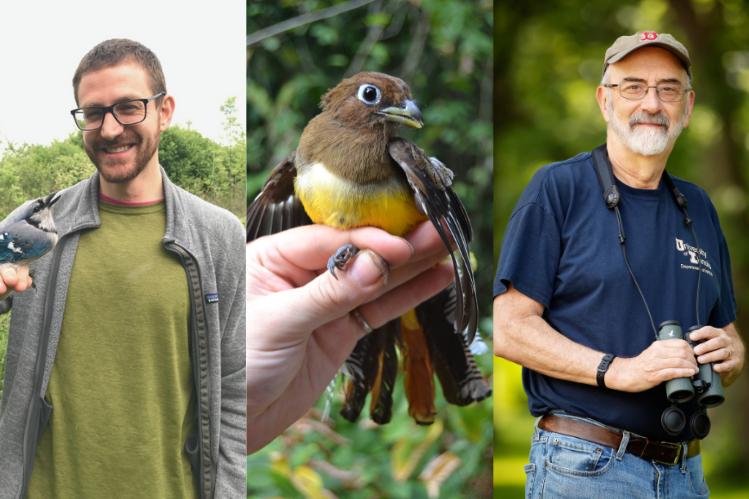Illinois study: Tropical birds could tolerate warming better than expected

Consider the globe, spinning silently in space. Its poles and its middle, the equator, remain relatively stable, thermally speaking, for the duration of Earth’s annual circuit around the sun. The spaces between — Earth’s temperate zones — experience seasons, with their characteristic temperature extremes.
It would follow that animals that evolved in each of these zones should match them, physiologically. We expect tropical animals to handle a certain degree of heat, but not wild swings in temperature. That seems to be the case for tropical ectotherms, or “cold-blooded” animals such as amphibians, reptiles, and insects. However, in a first-of-its-kind study of “warm-blooded” endotherms, a University of Illinois Urbana-Champaign team found tropical birds can handle thermal variation just fine.
“We tested the climate variability hypothesis, which predicts that organisms can't handle variation because they haven't seen it over evolutionary time,” said study co-author Jeff Brawn, professor emeritus in the Department of Natural Resources and Environmental Sciences (NRES), part of the College of Agricultural, Consumer and Environmental Sciences (ACES) at Illinois. “That may be true for ectotherms, but the evidence is just not there yet for birds in the Neotropics. Now we know they're able to handle it.”
Climate change may increase the average annual temperature in the tropics, as well as in microclimates like forest edges or tree canopies. The study provides some reassurance that, at least when looking at temperature alone, tropical birds should be okay. Why does that matter?
“The Neotropics alone are home to 40% of the world's bird species. Anyone who cares about birds should care about what’s happening in the tropics,” Brawn said. “Also, birds are important for the overall integrity of tropical forest systems, holding down insect populations that could damage trees.”
Brawn and co-author Henry Pollock, who did postdoctoral research in NRES, already showed that both temperate and tropical birds can withstand temperature extremes, disproving the climate variability hypothesis across latitudes. Their new study explains whether variation within habitats matters for specific groups of tropical birds.
Many tropical birds spend their lives deep in the forest understory. Their large eyes suggest they’re well adapted to the dark, where temperatures stay relatively cool and stable. Conversely, other bird groups zip between the forest canopy and its floor, or in and out of forest gaps and edges. These birds, Pollock reasoned, might have more tolerance to temperature fluctuations than their understory counterparts.
He captured birds from 89 species in Panama and, using a technique called respirometry, measured their metabolic rates across a range of temperatures. The birds were safely cooled and returned to their habitats after testing. He also took advantage of long-term weather station data provided by the Smithsonian Tropical Research Institute to document temperature differences across forest microclimates.
“If you measure temperature in an open area versus in the forest, there are large differences,” said Pollock, now the executive director of the Southern Plains Land Trust. “But we did not find any evidence that those differences translated into greater temperature tolerance among groups of tropical birds.”
Long-term observations indicate that when tropical forests become fragmented due to deforestation, an increasing phenomenon, certain groups of birds are more likely to decline. Insect-eating understory birds are among the hardest hit. For decades, tropical ornithologists believed narrow temperature tolerances may have been to blame for the declines of understory birds, but this study suggests otherwise.
Pollock is quick to point out that he only measured one aspect of an organism’s thermal environment. In the real world, temperature doesn’t increase in isolation; typically, when temperature goes up, so does solar radiation. Humidity and precipitation come into play, as well. And all of these things are part of the equation with habitat loss and climate change.
Still, one aspect of the climate variability and microclimate hypotheses can, for now, be put to rest for tropical birds.
“There's very little good news for tropical birds these days, but it's comforting that we've eliminated one factor as to what may go wrong with climate change. It's actually not a surprise; birds are very adaptable,” Brawn said. “Heat tolerance alone presents an incomplete situation, but this is further empirical evidence that, if it does get warmer, tropical birds may be able to tolerate a certain level of that.”
The study, “Equivocal support for the climate variability hypothesis within a Neotropical bird assemblage,” is published in Ecology [DOI: 10.1002/ecy.4206]. This research was supported in part by a National Science Foundation Graduate Research Fellowship to Henry Pollock; a U.S. Army Corps of Engineers Engineer Research and Development Center—Construction Engineering Research Laboratory (ERDC-CERL) grant (No. W9132T-11-2-0010) and U.S. Department of Agriculture National Institute of Food and Agriculture grant (No. 875370) to Jeff Brawn.